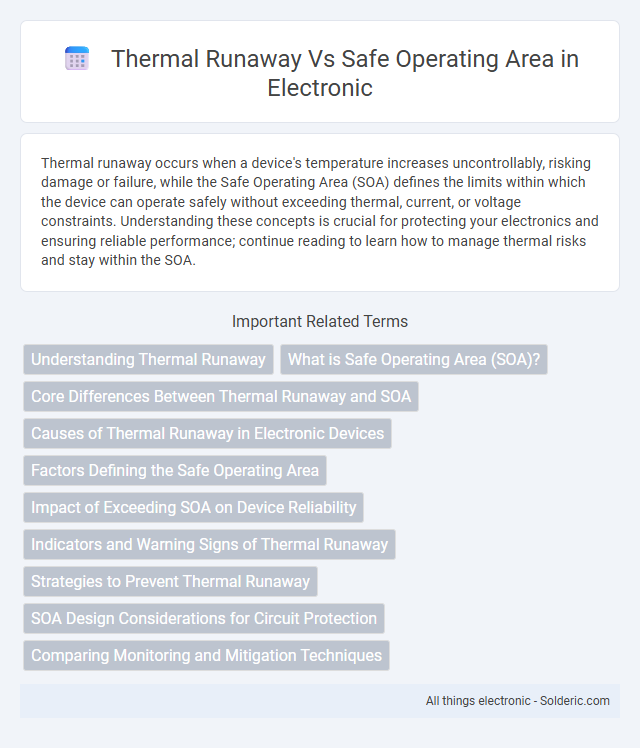Thermal runaway occurs when a device's temperature increases uncontrollably, risking damage or failure, while the Safe Operating Area (SOA) defines the limits within which the device can operate safely without exceeding thermal, current, or voltage constraints. Understanding these concepts is crucial for protecting your electronics and ensuring reliable performance; continue reading to learn how to manage thermal risks and stay within the SOA.
Comparison Table
| Aspect | Thermal Runaway | Safe Operating Area (SOA) |
|---|---|---|
| Definition | Uncontrolled temperature rise leading to device failure | Specified limits for voltage, current, and temperature ensuring device safety |
| Cause | Excessive power dissipation causing heat buildup | Operating conditions within manufacturer guidelines |
| Effect | Permanent damage or destruction of semiconductor device | Reliable and safe device performance |
| Prevention | Thermal management, heat sinks, current limiting | Operating within voltage, current, and temperature boundaries |
| Application | Power transistors, diodes, batteries under stress | Design guideline for transistors, MOSFETs, IGBTs |
| Monitoring Metrics | Junction temperature, power dissipation | Voltage rating, current rating, pulse duration, temperature |
Understanding Thermal Runaway
Thermal runaway occurs when an increase in temperature causes a device, such as a transistor, to conduct more current, leading to further temperature rises and potential device failure if not controlled. Understanding thermal runaway is critical for maintaining your device within its Safe Operating Area (SOA), which defines the limits of voltage, current, and temperature to prevent damage. Proper design and cooling mechanisms ensure thermal stability, safeguarding performance and extending device lifespan.
What is Safe Operating Area (SOA)?
Safe Operating Area (SOA) defines the voltage and current limits within which a semiconductor device, such as a transistor, can operate reliably without damage. It accounts for thermal and electrical constraints to prevent failures like thermal runaway, ensuring the device stays within safe thermal dissipation and maximum power ratings. Understanding your device's SOA is crucial for optimizing performance and avoiding catastrophic breakdowns during operation.
Core Differences Between Thermal Runaway and SOA
Thermal runaway occurs when an increase in temperature leads to a further rise in power dissipation, risking device destruction, while the Safe Operating Area (SOA) defines the electrical and thermal boundaries within which a device can function reliably. The core difference lies in thermal runaway being a failure mechanism driven by positive feedback, whereas SOA represents preventive design limits to avoid such failures. Understanding and managing SOA ensures devices operate safely, preventing thermal runaway and ensuring longevity.
Causes of Thermal Runaway in Electronic Devices
Thermal runaway in electronic devices occurs when heat generated within a component surpasses its ability to dissipate, causing a rise in temperature that further increases power dissipation. This phenomenon is often triggered by excessive current flow, inadequate heat sinking, or environmental conditions that elevate ambient temperature. Understanding the safe operating area (SOA) is crucial to prevent thermal runaway, as it defines the limits of voltage, current, and temperature to ensure device reliability and safety for Your electronics.
Factors Defining the Safe Operating Area
Factors defining the Safe Operating Area (SOA) include maximum voltage, current, power dissipation, and junction temperature limits for semiconductor devices. Thermal runaway occurs when heat generated exceeds the device's ability to dissipate it, pushing operation beyond these SOA limits and risking device failure. Understanding these parameters helps you design circuits that maintain device reliability by avoiding conditions that trigger thermal runaway within the SOA boundaries.
Impact of Exceeding SOA on Device Reliability
Exceeding the Safe Operating Area (SOA) in power semiconductors significantly increases the risk of thermal runaway due to excessive current and voltage stresses, leading to rapid device degradation. Thermal runaway occurs when localized heating reduces the material's resistance, causing increased current flow and further temperature rise, ultimately resulting in device failure. Maintaining operation within the SOA ensures thermal stability, enhancing device reliability and preventing catastrophic breakdowns.
Indicators and Warning Signs of Thermal Runaway
Thermal runaway often manifests through rapid temperature spikes, unexpected voltage drops, and abnormal current increases, indicating imminent device failure. Warning signs include discoloration, smoke, or unusual smells, signaling overheating within the Safe Operating Area (SOA) limits have been exceeded. Monitoring these indicators helps you prevent catastrophic damage by ensuring operations remain within the SOA boundaries.
Strategies to Prevent Thermal Runaway
Implementing adequate heat dissipation methods and selecting devices with robust Safe Operating Area (SOA) specifications are crucial strategies to prevent thermal runaway. You should design circuits with proper current limiting, employ thermal sensors for real-time monitoring, and use protective components such as fuses or thermal cutoffs to avoid exceeding device limits. Maintaining operation within the SOA ensures device reliability and minimizes the risk of catastrophic failure caused by excessive temperature rise.
SOA Design Considerations for Circuit Protection
Designing the Safe Operating Area (SOA) is critical for circuit protection to prevent thermal runaway, which occurs when a device's temperature increases uncontrollably due to excessive power dissipation. Key SOA design considerations include accurate thermal modeling, selecting components with adequate power ratings, and incorporating thermal feedback mechanisms to maintain junction temperature within safe limits. Implementing proper heat sinks, derating factors, and real-time monitoring ensures devices operate reliably under varying load conditions, effectively mitigating the risk of thermal runaway.
Comparing Monitoring and Mitigation Techniques
Thermal runaway monitoring techniques focus on real-time temperature sensing and rapid shutdown protocols to prevent device destruction, while Safe Operating Area (SOA) monitoring emphasizes voltage, current, and power limits to ensure devices operate within specified boundaries. Mitigation for thermal runaway involves advanced cooling systems and thermal interface materials to dissipate heat effectively, whereas SOA mitigation techniques include device derating and circuit redesign to avoid electrical stress. Your choice between these approaches depends on specific application requirements and the criticality of preventing thermal damage versus electrical overstress.
Thermal runaway vs Safe operating area Infographic

 solderic.com
solderic.com